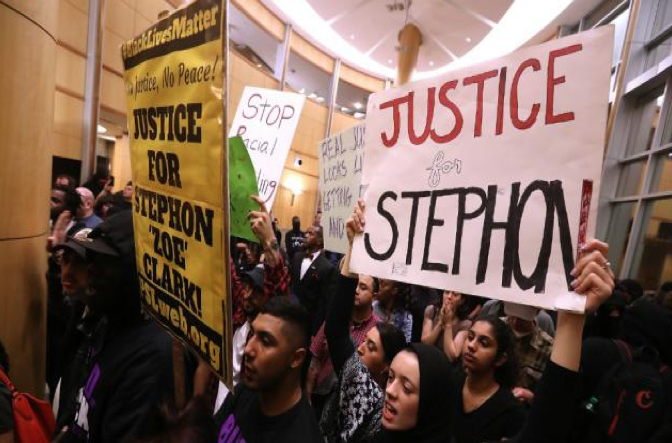CommentsCAL MATTERS-As the capital of the nation’s most complex and populous state, Sacramento is no stranger to protest marches and other forms of political expression.
However, the city has never experienced anything as emotionally powerful as the almost daily marches and rallies to condemn the city police shooting death of 22-year-old Stephon Clark in the backyard of his grandmother’s home on March 18.
Responding to reports of vandalism, two officers – steered to the backyard by a helicopter with infrared cameras – confronted Clark and when one of them saw something in Clark’s hand and shouted “gun,” the two unleashed a barrage of bullets from their semi-auto pistols, 20 in all.
The something turned out to be a cellphone, and a later autopsy ordered by Clark’s family and performed by Bennet Omalu, a famous forensic pathologist, revealed that he had been struck eight times, two in his side and six in the back.
The autopsy results and the video footage from the sheriff’s department helicopter and the two officers’ body cameras are shockingly persuasive that the protests about Clark’s death, which have drawn international attention, are fully justified.
In effect, those two officers sentenced someone suspected of relatively minor vandalism to death. And they did so while apparently ignoring even the most basic procedures governing the use of deadly force.
As anyone who has gone through firearms training, such as that required for a concealed weapons permit, can attest, deadly force is justified only when there is an immediate threat to oneself or another and when the target and the threat can be accurately identified. Moreover, one is supposed to use the minimum force necessary to counter the threat.
In this case, however, it was very dark, and Clark was a shadowy figure some yards away. The fact that one of the officers mistook a cellphone for a gun proves just how indistinct Clark was. Nevertheless, they unleashed a barrage of bullets in his general direction.
Only eight of the 20 shots hit Clark, meaning the other 12 went somewhere else in a crowded residential neighborhood, putting other lives in danger.
The autopsy indicated that Clark was facing the house, not the officers, when he was shot and that the two shots in his side spun him around so the other six hit him in the back.
Were a civilian to have fired at and killed a shadowy figure in a backyard under similar circumstances, he or she would almost certainly be prosecuted. It’s highly unlikely, however, that the two Sacramento cops will face criminal charges, because under long-standing law and practice, their belief that they were threatened will probably protect them.
Police work, of course, can be very dangerous. As the protests surged in Sacramento last week, a man named Luis Bracamontes was receiving the death penalty inside a Sacramento courtroom for the 2014 slayings of Sacramento sheriff’s Deputy Danny Oliver and Placer sheriff’s Detective Michael Davis Jr. And scarcely a week before Clark’s death, a Pomona police officer, Gregory Casillas, was shot to death and another policeman was severely wounded in a confrontation with Isaias De Jesus Valencia.
The vast majority of the men and women who patrol our streets are conscientious about the deadly force they are authorized to employ. But we cannot just shrug our shoulders about aberrations such as Clark’s pointless and tragic death. Something went terribly wrong that night and someone must be held accountable.
(Dan Walters has been a journalist for nearly 57 years, spending all but a few of those years working for California newspapers. He has written more than 9,000 columns about California and its politics. This Walters perspective originated at CalMatters a nonpartisan, nonprofit journalism venture committed to explaining how California’s state Capitol works and why it matters.) Prepped for CityWatch by Linda Abrams.
















